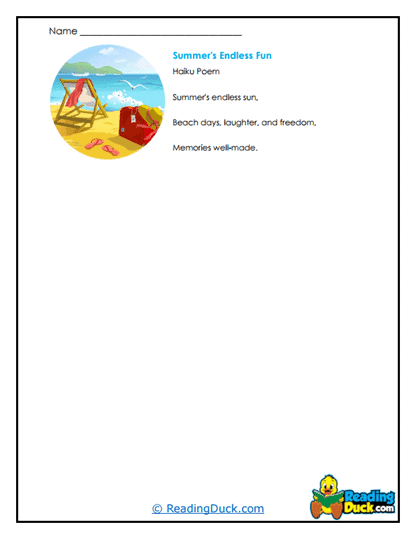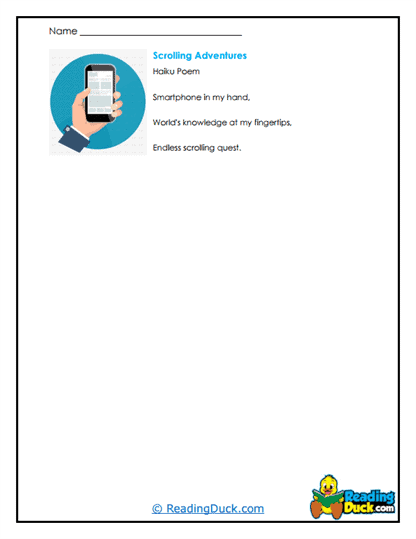Haiku Worksheets
About Our Haiku Worksheets
Our Haiku Worksheets offer an immersive and creative way for students to explore one of the most concise and profound forms of poetry. As part of the Reading Poetry category within the Genres section, this collection provides structured, thought-provoking activities that introduce students to the elegant simplicity of haiku. Each worksheet set includes a carefully chosen haiku poem, followed by multiple-choice questions, short answer questions, and open-ended response questions that encourage students to reflect on the poem’s themes, structure, and meaning.
These worksheets are conveniently available in PDF format, making them easy to download, print, and distribute for classroom lessons, homeschool projects, or independent study. Additionally, each worksheet set includes a downloadable answer key, allowing educators to efficiently assess student progress and comprehension. The Haiku Worksheets are designed to foster an appreciation for the beauty of this form while also developing critical reading and writing skills.
Understanding the Haiku: Themes, Structure, and Importance in Poetry
Haiku is a traditional Japanese form of poetry, renowned for its brevity and its focus on nature, the seasons, and human experience. Typically, a haiku consists of three lines with a syllabic pattern of 5-7-5, creating a compact and minimalist structure that demands precision in language. Haiku often capture a moment in time, evoking a sense of tranquility, reflection, or sudden insight. This genre has been essential in Japanese literature for centuries, offering a window into both the natural world and the emotional responses it elicits from humans.
A central theme in haiku is kigo (seasonal reference), where the poet hints at the time of year through imagery rather than direct description. For example, a mention of cherry blossoms might evoke spring, while a reference to snow suggests winter. Another key aspect of haiku is kireji (cutting word), which provides a verbal pause or contrast between ideas, creating a subtle tension or juxtaposition within the poem.
The importance of haiku in poetry lies in its ability to distill complex emotions and vivid imagery into just a few words. It teaches students the value of simplicity, focus, and attention to detail. Despite its brevity, haiku often conveys deep philosophical insights or evokes powerful emotional responses. Through studying haiku, students learn to appreciate the significance of every word and how form and content work together to create meaning.
- Key Themes: Nature, the seasons, human emotion, mindfulness, fleeting moments.
- Characteristics: Three-line structure, 5-7-5 syllable pattern, seasonal reference, juxtaposition.
- Significance: Haiku emphasizes simplicity and depth, teaching students to appreciate the power of concise language and imagery.
Our Haiku Worksheets allow students to explore these themes and characteristics while building their analytical and creative skills. The PDF format and included answer keys make these worksheets accessible and easy to use.
Building Essential Literary Skills Through Haiku Study
The Haiku Worksheets are designed to help students develop core literary skills, including reading comprehension, critical thinking, and creative expression. Through the study of haiku, students gain a deeper understanding of how language, structure, and meaning interact, and they learn to appreciate the artistry of poetry that conveys so much with so few words.
Each worksheet includes multiple-choice questions that focus on comprehension, helping students identify key elements of the poem such as the imagery, seasonal references, and the poet’s intent. These questions lay the foundation for understanding the poem’s surface meaning, ensuring that students grasp the essential elements of the text before moving into more complex analysis.
Short answer questions challenge students to examine the poem’s structure, such as how the syllabic pattern shapes the reading experience or how the use of kireji (cutting word) creates a shift in the poem’s tone or meaning. Open-ended response questions allow for deeper reflection, encouraging students to interpret the poem’s emotional and philosophical dimensions or to explore how the poet’s choice of imagery evokes a specific mood.
By working through these exercises, students develop several key skills:
- Reading Comprehension: Students learn to identify and interpret the key themes, images, and structure of haiku.
- Critical Thinking: Analyzing the poet’s use of language, form, and literary devices encourages deeper engagement with the poem.
- Creative Expression: Open-ended responses allow students to explore their personal interpretations of the poem and its deeper meaning.
These worksheets serve as a valuable tool for enhancing students’ ability to read and analyze poetry in a structured yet imaginative way.
Flexible Educational Resource for Varied Learning Environments
One of the key strengths of our Haiku Worksheets is their flexibility, making them an ideal resource for a wide range of educational settings, including classrooms, homeschooling, and independent study. Haiku’s brief yet profound nature lends itself to diverse learning environments, encouraging creativity and focus regardless of the instructional format.
In classroom settings, these worksheets can be incorporated into broader poetry units or used for focused haiku studies. Teachers can assign individual analysis or facilitate group activities, where students collaborate to interpret different haiku or create their own poems based on a shared theme. The worksheets are also excellent tools for classroom discussions, as students compare their interpretations and consider how different poets use similar structures to convey varied meanings.
For homeschooling, the Haiku Worksheets offer a structured yet adaptable approach to studying poetry. Parents or homeschool educators can guide students through the worksheets at their own pace, with opportunities for creative projects, such as writing haiku based on personal experiences or observations of nature. Homeschool students benefit from the balance of structure and creativity, building essential skills while exploring their own expressive abilities.
Independent learners can use the worksheets to engage with haiku on their own terms, gaining a thorough understanding of the genre while working through comprehension, analysis, and writing exercises. The PDF format ensures that the worksheets are easily accessible, and the included answer key provides immediate feedback for self-assessment.
- Classroom Use: Ideal for individual assignments, group projects, and class discussions.
- Homeschooling: Flexible and adaptable for different learning levels and paces.
- Independent Study: Self-paced exploration of haiku with easy access and self-assessment options.
This versatility ensures that the Haiku Worksheets can be effectively used in any learning environment, providing a valuable resource for both teachers and students.
Developing Analytical Skills and Deepening Poetry Interpretation
Studying haiku is an excellent way for students to sharpen their analytical skills and deepen their appreciation of literary devices such as metaphor, imagery, symbolism, and juxtaposition. Our Haiku Worksheets are carefully designed to guide students through a close reading of the poems, prompting them to think critically about how each word, line, and image contributes to the overall meaning and impact of the poem.
Through focused, genre-specific questions, students are encouraged to examine the poet’s use of structure, word choice, and literary devices. For example, they might analyze how the syllabic restrictions of the haiku form influence the selection of words and how a single image can evoke multiple layers of meaning. Questions also prompt students to explore the role of seasonal references, inviting them to consider how nature is used to reflect human emotions or philosophical insights.
The worksheets encourage students to move beyond surface-level interpretations, helping them develop a deeper understanding of how haiku conveys emotion and meaning through concise language. By learning to recognize and analyze the use of imagery, symbolism, and contrast, students become more confident in their ability to interpret poetry.
- Close Reading: Students analyze the careful use of structure, language, and imagery in haiku.
- Interpretation: Exploring how haiku uses simplicity to convey complex emotions or ideas.
- Literary Devices: Identifying and understanding key poetic devices such as metaphor, symbolism, and juxtaposition.
These exercises help students develop the skills necessary to engage with haiku and other forms of poetry at a deeper, more critical level.
Encouraging Creative Writing Through Haiku
One of the most rewarding aspects of our Haiku Worksheets is the opportunity they provide for creative expression. Writing haiku requires students to think carefully about language, structure, and imagery, making it an ideal exercise for developing both analytical and creative skills.
Each worksheet set includes creative writing prompts that encourage students to craft their own haiku, drawing inspiration from personal experiences, observations of nature, or reflections on specific themes. For example, students might be asked to write a haiku that captures a moment of beauty in their daily life or one that reflects a change in season. These prompts help students apply the techniques they have studied, such as the use of seasonal imagery, syllabic patterns, and kireji (cutting words), in their own writing.
By experimenting with the form, students gain a deeper understanding of how haiku works while also discovering their voice as poets. Writing haiku encourages mindfulness, focus, and creativity, as students learn to distill their thoughts and emotions into a few carefully chosen words.
- Writing Prompts: Guided exercises encourage students to write their own haiku.
- Creative Expression: Students explore how language and imagery can be used to express their ideas.
- Practical Application: Writing exercises help students apply the techniques and themes they have learned.
These creative writing activities allow students to develop their writing skills while fostering a deeper connection with the haiku genre.
Conclusion: A Comprehensive Approach to Exploring Haiku
Our Haiku Worksheets offer a well-rounded and engaging resource for students and educators alike. By combining reading comprehension, critical analysis, and creative writing, these worksheets provide students with the tools they need to explore and appreciate the simplicity and depth of haiku. Whether used in classrooms, for homeschooling, or as part of an independent study program, the worksheets offer flexibility and support for a wide range of learning environments.
Through guided exercises in close reading, literary analysis, and creative writing, students gain a deeper understanding of haiku and the ways in which this concise form of poetry can convey powerful emotions and ideas. With our Haiku Worksheets, students not only learn to interpret haiku but also have the opportunity to create their own, discovering the beauty and complexity of this timeless genre.









